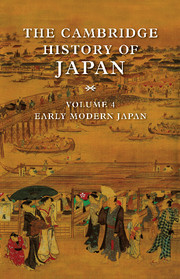Crossref Citations
This Book has been
cited by the following publications. This list is generated based on data provided by Crossref.
White, James W.
1993.
Cycles and Repertoires of Popular Contention in Early Modern Japan.
Social Science History,
Vol. 17,
Issue. 3,
p.
429.
Howland, Douglas R.
2001.
Samurai Status, Class, and Bureaucracy: A Historiographical Essay.
The Journal of Asian Studies,
Vol. 60,
Issue. 2,
p.
353.
2003.
Geschichtswissenschaft jenseits des Nationalstaats.
p.
46.
Guillaume, Xavier
2004.
Misdirected Understandings.
Japanstudien,
Vol. 15,
Issue. 1,
p.
85.
Lieberman, Victor
2008.
Protected Rimlands and Exposed Zones: Reconfiguring Premodern Eurasia.
Comparative Studies in Society and History,
Vol. 50,
Issue. 3,
p.
692.
Wilson, Noell
2011.
The Encyclopedia of War.
Swope, Kenneth M.
2011.
The Encyclopedia of War.
M. Swope, Kenneth
2011.
The Encyclopedia of War.
Swope, Kenneth M.
2011.
The Encyclopedia of War.
Black, Jeremy
2011.
Beyond the Military Revolution.
p.
28.
2012.
Pacific Worlds.
p.
379.
Bianchi, Alessandro
2014.
Introduction to Medicine or Satire on Doctors.
East Asian Publishing and Society,
Vol. 4,
Issue. 1,
p.
65.
Hayami, Akira
2015.
Japan’s Industrious Revolution.
p.
1.
Matos, Ânia Soeiro
2016.
O ensino de Português na Ásia Oriental : de quem para quem.
Forum Sociológico,
Vol. 28,
Issue. ,
Hesselink, Reinier H.
2018.
The Encyclopedia of Diplomacy.
p.
1.
Wrona, Jens
2018.
BORDER EFFECTS WITHOUT BORDERS: WHAT DIVIDES JAPAN'S INTERNAL TRADE?.
International Economic Review,
Vol. 59,
Issue. 3,
p.
1209.
2021.
L’église des laïcs.
p.
369.
Anderson, Nicholas D.
2023.
Introducing the Warring-States Japan Battle Data.
International Interactions,
Vol. 49,
Issue. 1,
p.
147.
Gigante, Michael John
Stone, Joshua
Druckman, Daniel
and
Wan, Ming
2025.
The Rise and Fall of the Confucian Long Peace: A New Dataset for Analyzing Regional Conflict Management in East Asia (1598–1894).
Journal of Conflict Resolution,



